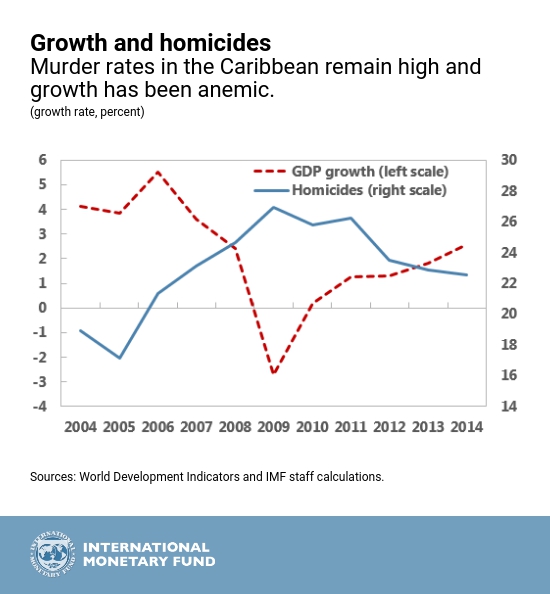
Worker at Jamaica’s national stadium in Kingston. The global financial crisis contributed to high levels of unemployment in the Caribbean (photo: Ivan Alvarado/Reuters/Newscom)
Crime and Youth Unemployment in the Caribbean
November 14, 2017
Crime and violence are one of the key bottlenecks to growth in the Caribbean. Together with a labor market that does not adapt easily to changes, high crime rates have created a vicious cycle by which young people struggling with the lack of economic opportunities turn to illegal activities and crime, further depressing growth.
Related Links
Growth in the region has stalled since 2000, generating few jobs and high levels of unemployment. The 2008 global financial crisis had an especially strong effect on the unemployment rate for those between the ages of 15 and 24, which jumped on average by 5 percentage points between 2007 and 2013—from 21 percent to 26 percent. In some countries (for example, the Bahamas, Barbados, and Jamaica), youth unemployment rates are nearly three times that of those aged 30 and over.
Meanwhile, crime has risen sharply since 2004 in the region and murder rates are now among the highest in the world. More specifically, violent crime in the Caribbean is significantly higher than in any other region (with 6.8 percent of the population affected versus a world average of 4.5 percent), according to a forthcoming IMF book, Unleashing Growth and Strengthening Resilience in the Caribbean. About 40 percent of the Caribbean population identifies crime and security-related issues as the biggest problem facing their countries, even more than poverty or inequality.
Crime mostly affects youth
According to the 2012 UN Caribbean Human Development Report, young people are both the primary victims and perpetrators of crime in the region. Victims of violent crime are predominantly between the ages of 18 to 30 and from lower levels of income, while 80 percent of prosecuted crimes were committed by people aged 17 to 29 years.
Studies suggest that being a victim or a perpetrator of crime can generate negative labor market outcomes, including lower wages and longer and more frequent unemployment spells because of decreased productivity and psychological costs. In a region where over 60 percent of the population is under the age of 30, this could entail long-term consequences for growth.
A vicious cycle
Weak growth reduces economic opportunities for the young, increasing their vulnerability to victimization or gang membership. These trends further hurt growth by discouraging investment through lower productivity, higher security costs and reduced competitiveness. They also divert government spending from growth-enhancing investment in health, education, and productive infrastructure, create uncertainty for businesses and investors, and cause the emigration of highly trained people (also known as brain drain).
According to recent research by the Inter-American Development Bank, direct crime-related costs range from 3 to 5 percent of GDP in the Caribbean every year, compared to 2 percent of GDP in advanced economies. In addition, forthcoming IMF research suggests that if Caribbean countries were to lower their murder rates to those of, say Canada (for illustrative purposes), growth would be between 0.4–0.7 percentage points higher per year. Illustrative results using Caribbean victimization surveys also find that being a victim of a crime increases a respondent’s desire to emigrate by over 5 percentage points. In fact, addressing crime in Jamaica, Belize, Bahamas, and St. Kitts and Nevis would yield higher gains to growth than increasing human capital levels alone, as the latter can be lost to brain drain if crime is not addressed.

An integrated solution
Efforts to fight crime in the Caribbean have largely concentrated on punitive rather than preventive measures. As a result, prevention is often under-resourced with the bulk of public security spending flowing to deterrence. From an economic perspective, criminals chose illegal activities because their expected payoffs (that is, profits from crime) are higher than those of legal activities. The solution must therefore lie in an integrated strategy, where payoffs to legal activities are increased (for example, by raising the expected return to education in the domestic labor market and increasing formality), and crime prevention and deterrence programs (parenting and mentoring programs, urban renewal programs, and victims’ support) are given equal importance.
Targeting at-risk youth for vocational and social programs increases the possibility that they will gain legal earnings and obtain respect through nonviolent means, while concurrently reducing youth unemployment. At the same time, improved policing and a more effective criminal justice system increase the expected cost of committing crimes, improving deterrence.
The limited public resources should be targeted towards high-crime areas and the most vulnerable. Moreover, initiatives should be subjected to rigorous evaluations, which require better data collection, monitoring, and sharing (for example, number of arrests, types of crime, cases that proceed to trial and conviction, prison population, and program participation), and funding support. The private sector also plays a pivotal role, including through the training for at-risk-youth, funding urban renewal programs, and directly sponsoring victimization surveys and data collection.












